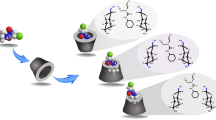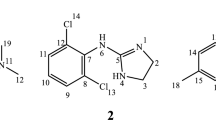Abstract
Purpose. The objective of the study was to obtain structural information of inclusion complexes of tolbutamide with HP-α- and -β-cyclo-dextrins in amorphous state.
Methods. The solid complexes of tolbutamide with HP-α- and -β-CyDs in molar ratios of 1:1 and 1:2 (guest:host) were prepared by the spray-drying method, and their interactions were investigated by solid-state I3C nuclear magnetic resonance (NMR) spectroscopy.
Results. The solid 1:1 and l:2tolbutamide/HP-CyD complexes showed halo pattern on the powder X-ray diffractogram and no thermal change in DSC curves, indicating they are in an amorphous state.13C NMR signals of the butyl moiety were broader than those of the phenyl moiety in the HP-α-CyD solid complex, whereas the phenyl moiety showed significantly broader signals than the butyl moiety in the HP-β-CyD solid complex. As temperature increased, signals of the phenyl carbons became markedly sharper, whereas the butyl carbons only sharpen slightly in the HP-d-CyD complex. In contrast, signals of the butyl carbons became significantly sharper whereas those of phenyl carbons only slightly changed in the HP-β-CyD complex.
Conclusions. Solid state 13C NMR spectroscopic studies indicated that the butyl moiety of tolbutamide is predominantly included in the HP-α-CyD cavity, whereas the phenyl moiety in the HP-β-CyD cavity in amorphous complexes.
Similar content being viewed by others
REFERENCES
M. L. Bender and M. Komiyama. Cyclodextrin Chemistry. Springer-Verlag, Berlin, 1978.
F. Hirayama and K. Uekama. Method of investigating and preparing inclusion compounds. In D. Duchêne (eds), Cyclodextrins and Their Industrial Uses, Edition de Santé, Paris, 1987, pp. 133–172.
K. A. Connors. The stability of cyclodextrin complexes in solution. Chem. Rev. 97:1325–1357 (1997).
Y. Inoue. NMR studies of the structure and properties of cyclodextrins and their inclusion complexes. Annu. Rep. NMR Spectrosc. 27:59–101 (1993).
W. Saenger. Cyclodextrin inclusion compounds in research and industry. Angew. Chem. Int. Ed. Engl. 19:344–362 (1980).
K. Harata. Structural aspects of stereodifferentiation in the solid state. Chem. Rev. 98:1803–1827 (1998).
H. M. Rietveld. A profile refinement method for nuclear and magnetic structures. J. Appl. Crystallogr. 2:65–71 (1969).
F. Izumi, H. Asano, H. Murata, and N. Watanabe. Rietveld analysis of powder patterns obtained by TOF neutron diffraction using cold neutron sources. J. Appl. Crystallogr. 20:411–418 (1987).
K. Honda, M. Goto, and M. Kurahashi. Structure determination of 5-aminovaleric acid from synchrotron powder diffraction data obtained by large radius camera. Chem. Lett. 1990:13–16.
D. E. Bugay. Solid-state nuclear magnetic resonance spectroscopy: Theory and pharmaceutical applications. Pharm. Res. 10:317–327 (1993).
P. Gao. Determination of the composition of delavirdine mesylate polymorph and pseudopolymorph mixtures using 13C CP/MAS NMR. Pharm. Res. 12:945–954 (1996).
B. W. Müller and U. Brauns. Solubilization of drugs by modified β-cyclodextrins. Int. J. Pharm. 26:77–88 (1985).
J. Pitha and J. Pitha. Amorphous water-soluble derivatives of cyclodextrins: Nontoxic dissolution enhancing excipients. J. Pharm. Sci. 74:987–990 (1985).
T. Loftsson and M. Brewster. Pharmaceutical applications of cyclodextrins. 1. Drug solubilization and stabilization. J. Pharm. Sci. 85:1017–1025 (1996).
K. Uekama, F. Hirayama, N. Matsuo, and M. Komiyama. Structural elucidation of the inclusion complexes of tolbutamide with α-and β-cyclodextrins in aqueous solution. Chem. Lett. 1978:703–706.
H. Ueda and T. Nagai. Solid-state nuclear magnetic resonance spectroscopy and raman spectroscopy of inclusion compound of tolbutamide with β-cyclodextrin. Chem. Pharm. Bull. 28:1415–1421 (1981).
T. Higuchi and K. A. Connors. Phase-solubility techniques. Adv. Anal. Chem. Instrum. 4:117–212 (1965).
T. Higuchi and H. Kristiansen. Binding specificity between small organic solutes in aqueous solution: Classification of some solutes into two groups according to binding tendencies. J. Pharm. Sci. 59:1601–1608 (1970).
F. Kedzierewics, M. Hoffman, and P. Maincent. Comparison of tolbutamide β-cyclodextrin inclusion compounds and solid dispersions. Physicochemical characteristics and dissolution studies. Int. J. Pharm. 58:221–227 (1990).
P. Job. Formation and stability of inorganic complexes in solution. Ann. Chem. 9:113–203 (1928).
A. P. Bisson, C. A. Hunter, J. C. Morale, and K. Young. Cooperative interaction in a ternary mixture. Chem. Eur. J. 4:845–851 (1998).
K. Yamaoka, Y. Tanigawara, T. Nakagawa, and T. Uno. A pharmacokinetic analysis program (MULTI) for microcomputer. J. Pharm. Dyn. 4:879–885 (1981).
K. Kimura, F. Hirayama, and K. Uekama. Characterization of tolbutamide polymorphs (Burger's forms II and IV) and polymorphic transition behavior. J. Pharm. Sci. 88:385–391 (1999).
Y. Inoue, T. Okuda, F.-H. Kuan, and R. Chûjô. A cross-polarization-magic angle spinning 13C-N.M.R. study of solid-state cycloamylose inclusion complexes with substituted benzenes: 13C-chemical shifts and molecular dynamics of the included guest. Carbohydr. Res. 129:9–20 (1984).
J. A. Ripmeester. Variable temperature CP/MAS 13C NMR study of cyclodextrin complexes of benzaldehyde. J. Incl. Phenom. 6:31–40 (1988).
K. Takegoshi and K. Hikichi. Tautomeric proton transfer of tropolone included in α-and β-cyclodextrins. J. Am. Chem. Soc. 115:9747–9749 (1993).
W. P. Rothwell and J. S. Waugh. Transverse relaxation of dipolar coupled spin systems under r.f. irradiation: detecting motions in solids. J. Chem. Phys. 74:2721–2731 (1981).
Author information
Authors and Affiliations
Corresponding author
Rights and permissions
About this article
Cite this article
Kimura, K., Hirayama, F., Arima, H. et al. Solid-State 13C Nuclear Magnetic Resonance Spectroscopic Study on Amorphous Solid Complexes of Tolbutamide with 2-Hydroxypropyl-α-and -β-Cyclodextrins. Pharm Res 16, 1729–1734 (1999). https://doi.org/10.1023/A:1018958116349
Issue Date:
DOI: https://doi.org/10.1023/A:1018958116349




